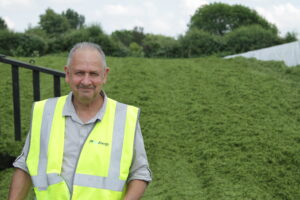Biogas grass silage additive proves value after two difficult seasons

Silasil Energy SG has delivered impressive results across a range of situations from high dry matter grasses in the West Midlands to wet fourth-cut silage in Northern Ireland.
Silasil Energy SG was specifically developed to provide a silage additive for the variability of UK-grown grass, and is equally effective at a range of dry matters, temperatures and pH levels.
Featuring a unique combination of four bacterial strains, instead of the usual two found in other silage additives, it has proven ideal for the unpredictable summer weather seen across the UK in recent years.
Andy Lee, FM BioEnergy’s UK Forage Manager, explains: “In the UK and Ireland, we’ve had two years with highly unpredictable weather for making silage. In some areas it was wet early, in others it was too hot during mid-summer, drying crops out. In Northern Ireland particularly, they have had two atrocious years. This means that farmers have faced really challenging conditions. However, Silasil Energy SG has proved its effectiveness in two of the worst years possible for silage production.”
Saving wet silage
One user grateful for the benefits of Silasil Energy SG is Willsborough AD near Derry/Londonderry in Northern Ireland.
The 500 kW on-farm biogas plant is predominantly fed using grass silage and wholecrop silage but with average rainfall around 3.6 inches (92mm) per month, it can be hard to produce the recommended minimum dry matter content of 25%.
“I’m really pleased with the results we’ve had from using Silasil Energy SG this season,” said Willsborough AD owner Rob Gallagher. “In the past we’ve had issues with clamps heating and spoiling. However, with Silasil Energy SG, from the front of the clamp to the very end, the feedstock remains cold and free from yeasts and moulds all the way through the season. This hasn’t always been the case with some of the other silage additives we’ve tried over the years.”
“The amount of rainfall in Northern Ireland and the north of England can make it very hard to produce dry silage,” explained Andy Lee. “Ideally, silage should be wilted for a maximum of 36 hours otherwise the aerobic bacteria start to consume all the nutrients, but wet weather can delay this.
"The other issue is that multiple turning of windrows to dry wet grass increases the chance of contamination with soil, manure, etc, increasing the risks of butyric acid formation. It is therefore more important to harvest it within 36 hours of cutting, irrespective of how dry it is, and the beauty of Silasil Energy SG is that it will preserve the crop even at low dry matters.”
Analysis in April 2025 after 22 weeks of storage showed that last year’s fourth cut silage, which had dry matter below 24% at harvest, was still in good condition with good gas yield potential. “Despite low dry matter of just 22%, key quality parameters including protein and acid levels were good, and the pH was below 4,” adds Andy. “Without the use of Silasil Energy SG that silage would have been completely unusable due to its low dry matter.”
Equally good for dry silage
While Northern Ireland and the west of Scotland were wetter than average last year, in the West Midlands it was a different story, with areas such as Shropshire getting less than 20% rain than average.
This poses a different challenge – one major dairy farm with a 1.4 MW biogas plant produced first cut grass silage above 40% dry matter last summer. The farm trialled Silasil Energy SG and the results have been conclusive.
“Their first cut grass silage had almost 41% dry matter with high protein and digestibility,” explained Andy. “When we tested samples from the clamp in March 2025, there were no yeasts or moulds, and the crop was very stable. In fact, the analysis was one of the best results for grass silage I’ve ever seen.
“The farmer particularly likes the fact that he doesn’t have to worry about what the summer weather is going to be like – he knows the product will work equally well, whether it’s a washout or a scorcher. Plus, keeping the biogas silage clamps free from yeasts and moulds helps to reduce the risk of contaminating the dairy cattle feed elsewhere on the farm.”
Experience reinforces original trials
The experiences of FM BioEnergy’s customers throughout 2024 underline the results from initial trials at Vale Green Energy’s 1.5 MW Spring Hill AD plant. Vale Green trialled Silasil Energy SG on 12,000 tonnes of grass silage harvested from three cuts in 2023, and Feedstock Manager Nick Reynolds was impressed with the results. “Not only is it easy to apply, but it works on both wet and dry grass, keeping the clamp face cool and ensuring the energy stays in the silage,” he commented.
Samples of treated and untreated grass at harvest showed that levels of lactic acid and acetic acid in the samples that had been treated with Silasil Energy SG had doubled after just three days compared to the untreated silage. Average acetic acid levels were 0.454 in the treated samples, compared to 0.178 in the untreated samples. Seven months later, acid levels were equally high, and the pH remained stable at just under 4. Given this, it’s no surprise that Vale Green used Silasil Energy SG on all its grass silage again in 2024.
“With positive results from very different samples across two difficult years, Silasil Energy SG has proven itself to be an extremely reliable grass silage additive irrespective of the weather conditions or dry matter of the silage being produced,” emphasised Andy Lee.















